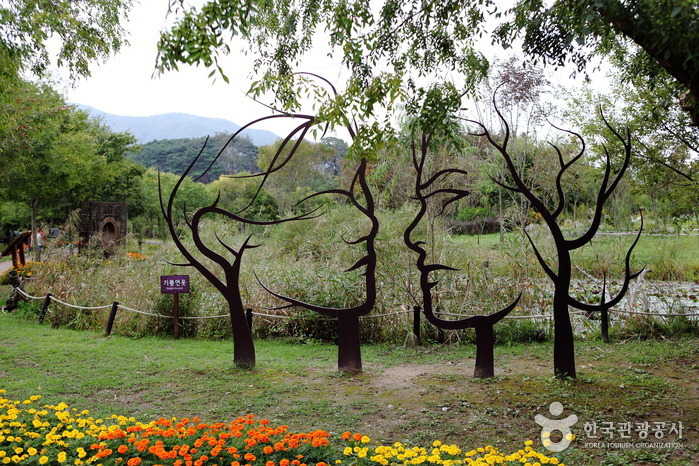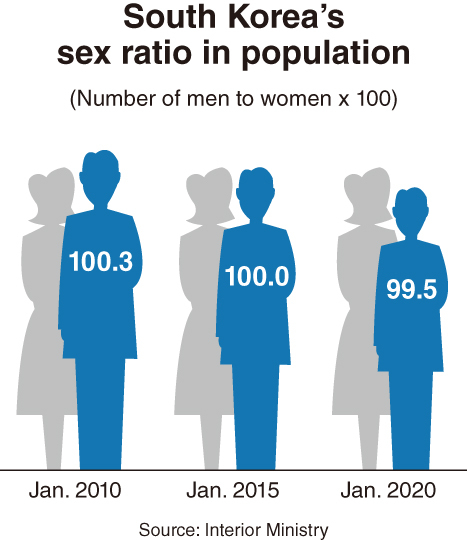
Trees are seen an ecological park on the Yeongsan River in Gwangju, where the male-to-female ratio stood at 97.9 per 100 in January 2020, or 720,931 vs. 735,757. It was the fourth-lowest figure in the nation, with only Seoul, Busan and Daegu posting lower ratios. (Korea Tourism Organization)
SEJONG -- Women have longer lifespans than men, and a government database suggests that the gender gap in South Korea’s population will grow wider in the coming years and decades.
According to the Ministry of Interior and Safety, women outnumbered men by 121,783 as of January 2020. The sex ratio, or the number of men per 100 women, posted an all-time low of 99.5, down 0.1 percentage point from a year earlier.
The nation’s male and female populations stood at 25.862 million and 25.984 million, respectively, last month.
In Korea, women began to outnumber men 55 months ago. The turning point was June 2015, when the sex ratio fell to 99.9 -- the first time in history it had dropped below 100 since the nation began compiling relevant data. At that time, there were 25.7153 million male Koreans to 25.7157 million female Koreans.
The ratio has further declined by about 0.1 percentage point per annum over the past few years -- to 99.8 in January 2017, 99.7 in January 2018 and 99.6 in January 2019.
The respective figures for five years earlier, January 2015, and 10 years earlier, January 2010, were 100.03 and 100.3.

(Graphic by Han Chang-duck/The Korea Herald)
“Generally -- based on genetics research on boy’s higher probability among newborns across the globe -- Korea also sees boys slightly outnumber girls in childbirth. In addition, preference for sons is still existing though the trend is drastically waning,” a government official said.
“Nevertheless, the recent changeover in the sex ratio could be attributable to women’s longer lifespan compared to men. Further, higher mortality of men among the middle-aged is seen like death from overwork, in Korea,” he said.
Ministry data showed that the number of men aged between 70 and 79 was 1.61 million across the nation as of January 2020, while the figure for women in the corresponding age group tallied 1.99 million.
The demographic disparity was even more pronounced for people aged 80 and over: Korean men in their 80s were outnumbered 1.07 million to 570,000. For those in their 90s, the gulf was still wider at 171,000 to 53,000 and for centenarians it was 15,483 to 4,898.
Furthermore, the total population of Korean men fell for the sixth consecutive month since August 2019: minus 261, minus 354, minus 844, minus 575, minus 1,788 and minus 1,953.
In contrast, the female population fell in January 2020 for the first time in history (minus 399) after recording a continuous increase every month during the period of August-December 2019.
However, boys still outnumber girls among newborn babies. Last month 12,700 baby boys were born, compared with 11,993 girls.
Boys outnumbered girls among newborns in 14 of the nation’s 17 major areas, including Seoul, Busan, Incheon, Daegu, Daejeon, Sejong and Gyeonggi Province. But more girls were born in Gwangju, Ulsan and North Chungcheong Province.
Among babies born nationwide, boys outnumbered girls every month over the past 70 months -- since January 2014, when the government started compiling, or publicizing, its official data.
Meanwhile, the sex ratio showed deviations among the nation’s eight major cities and nine provinces last month. The disparities stem from regional characteristics such as urbanization and the presence of farming communities, service industries, military zones and manufacturing towns.
Seoul recorded the lowest ratio of males to females, 95.1 per 100 or 4.74 million to 4.98 million. Women in the capital have tended to outnumber men for more than a decade.
Busan ranked second from last at 96.3, just below Daegu at 97.7, Gwangju at 97.9, North Jeolla Province at 98.8, Sejong at 99.4 and Daejeon at 99.7.
But the remaining 10 areas still saw men outnumber women. In this regard Ulsan, a manufacturing-oriented city, topped the list with a sex ratio of 105.6. Next were South Chungcheong Province with 103.9 and North Chungcheong Province with 102.6.
Gyeonggi Province, the nation’s most populous area, posted a sex ratio of 101.2 with 6.66 million males vs. 6.58 million females. Other areas that hovered around the 101 mark included Incheon, Jeju Province and North Gyeongsang Province.
By Kim Yon-se (kys@heraldcorp.com)


![[Exclusive] Korean military set to ban iPhones over 'security' concerns](http://res.heraldm.com/phpwas/restmb_idxmake.php?idx=645&simg=/content/image/2024/04/23/20240423050599_0.jpg&u=20240423183955)




![[Herald Interview] 'Amid aging population, Korea to invite more young professionals from overseas'](http://res.heraldm.com/phpwas/restmb_idxmake.php?idx=645&simg=/content/image/2024/04/24/20240424050844_0.jpg&u=20240424200058)